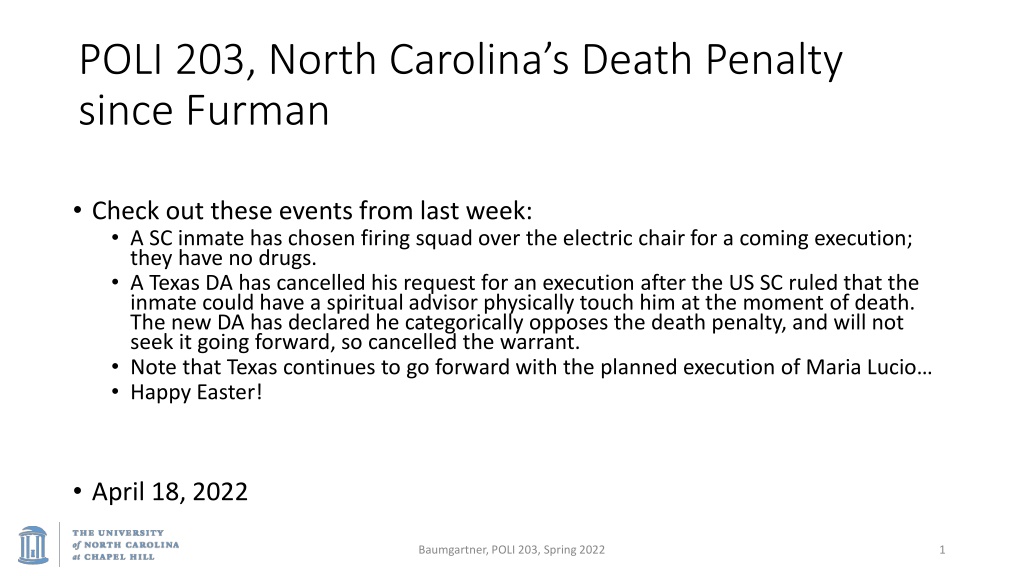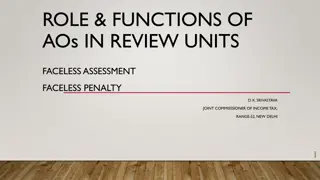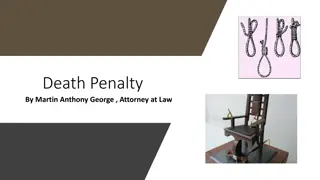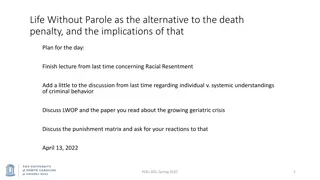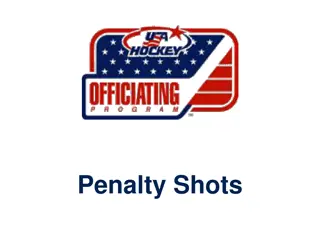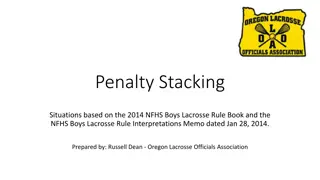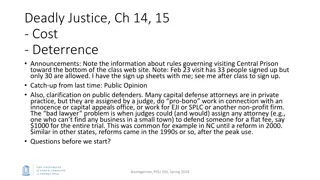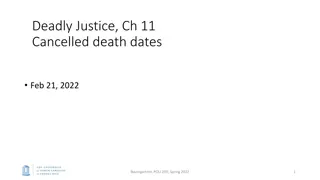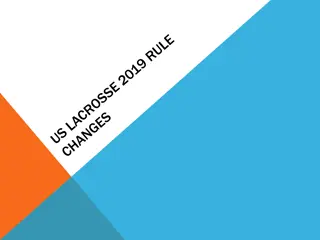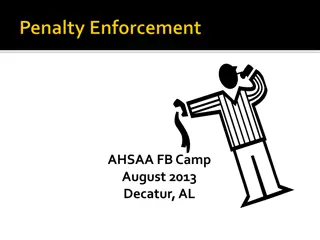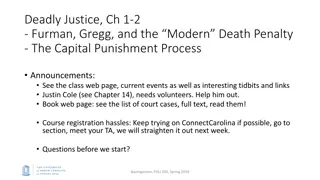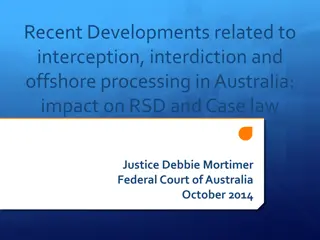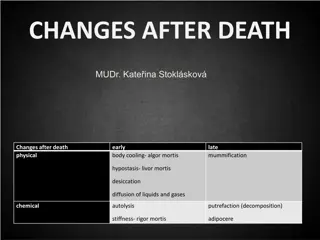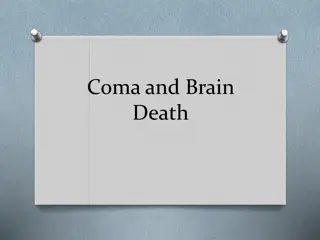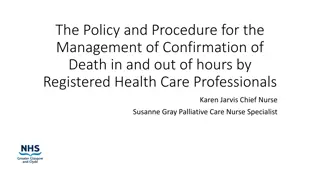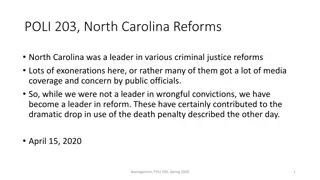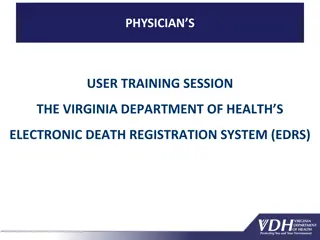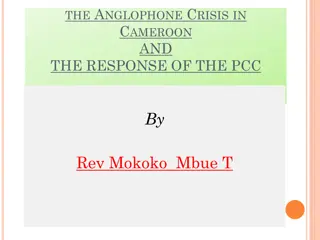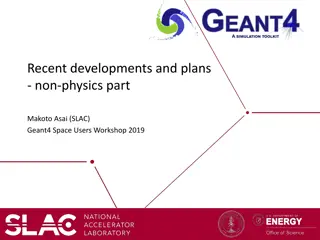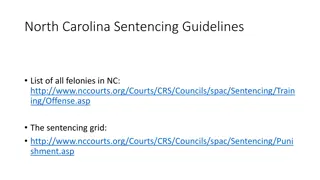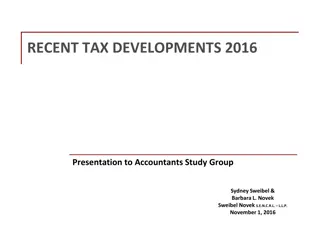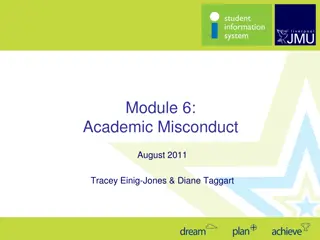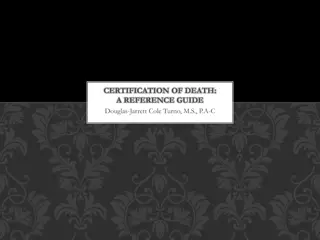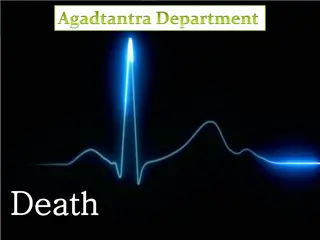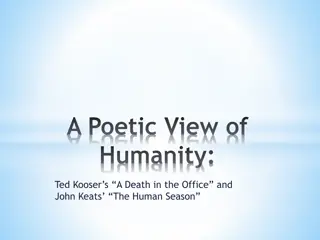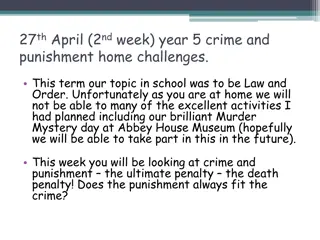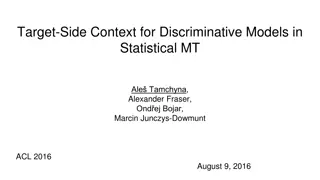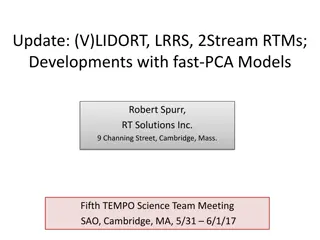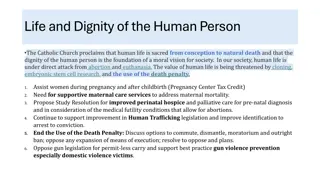North Carolina's Death Penalty System Since Furman: Recent Developments and Historical Context
Last week’s events in North Carolina regarding the death penalty include an inmate choosing firing squad due to lack of drugs, a Texas DA cancelling an execution request after a spiritual advisor ruling, and the new DA opposing the death penalty. The historical background of North Carolina's death penalty system from 1972 to the present, response to Furman, and key legal cases are highlighted. Links to further reading and upcoming class activities are also provided.
Download Presentation

Please find below an Image/Link to download the presentation.
The content on the website is provided AS IS for your information and personal use only. It may not be sold, licensed, or shared on other websites without obtaining consent from the author. Download presentation by click this link. If you encounter any issues during the download, it is possible that the publisher has removed the file from their server.
E N D
Presentation Transcript
POLI 203, North Carolinas Death Penalty since Furman Check out these events from last week: A SC inmate has chosen firing squad over the electric chair for a coming execution; they have no drugs. A Texas DA has cancelled his request for an execution after the US SC ruled that the inmate could have a spiritual advisor physically touch him at the moment of death. The new DA has declared he categorically opposes the death penalty, and will not seek it going forward, so cancelled the warrant. Note that Texas continues to go forward with the planned execution of Maria Lucio Happy Easter! April 18, 2022 Baumgartner, POLI 203, Spring 2022 1
Please send me questions for next week. Note: Next week is the last week of class. I will miss you! My plan for Monday s lecture: Answer whatever questions you have. Please email them to me by Friday of this week, and I will answer them. Ask anything you want. On Wed. next week we ll focus on an exam review. Baumgartner, POLI 203, Spring 2022 2
NC death penalty system For historical background, see Seth Kotch, Lethal State. Seth is a professor in American Studies. He s an historian; also works on lynching (Take any class he teaches.) My focus here: 1972-present Baumgartner, POLI 203, Spring 2022 3
NC and Louisiana respond to Furman with mandatory death for all eligible crimes NC response to Furman: No legislation at all. The NC SC ruled that if the current law is ruled invalid, we simply revert to the previous law. That law dated to the 1940s and mandated death as the sole punishment for first-degree murder At the time, it was common for governors to commute, and even for judges to ask the governor to commute the sentence when they gave the sentence. Obviously this is no longer the case. Baumgartner, POLI 203, Spring 2022 4
NC and LA mandatory schemes ruled unconstitutional in 1976 Woodson v. North Carolina (please review it on the book web page, legal citations section): it s very simple. Any law that mandates death as the punishment for a certain class of crimes is cruel and unusual. Roberts v. Louisiana: same ruling. So, in response to that, NC did pass a law. Mandatory prosecution. Jury can then decide. Baumgartner, POLI 203, Spring 2022 5
The NC death penalty statute: https://www.ncleg.gov/EnactedLegislation/Statutes/HTML/BySection /Chapter_14/GS_14-17.html 14-17,a: A murder which shall be perpetrated by means of a nuclear, biological, or chemical weapon of mass destruction as defined in G.S. 14-288.21, poison, lying in wait, imprisonment, starving, torture, or by any other kind of willful, deliberate, and premeditated killing, or which shall be committed in the perpetration or attempted perpetration of any arson, rape or a sex offense, robbery, kidnapping, burglary, or other felony committed or attempted with the use of a deadly weapon shall be deemed to be murder in the first degree, a Class A felony. Baumgartner, POLI 203, Spring 2022 6
Aggravating circumstances separately listed https://www.ncleg.net/EnactedLegislation/Statutes/HTML/BySection /Chapter_15A/GS_15A-1340.16.html There are more than 20 things listed, too long for a slide. Includes several vague things: Gang-related especially heinous, atrocious, or cruel great risk of death to more than one person Killer was armed or used a deadly weapon #20: Any other aggravating factor reasonably related to the purposes of sentencing (Note: Mitigating factors also listed a similarly long list.) Baumgartner, POLI 203, Spring 2022 7
North Carolina leads the nation in death sentencing (1972-1976) The NC death row was emptied, like all others, in 1972 But it filled up again very quickly under the mandatory death sentence law in place from 1972 to 2001 July 1, 1976: 115 individuals on death row All these sentences were ruled invalid by Woodson v. North Carolina March 1978: just six people on death row NC death row was the largest in the nation in 1976 Of the first 100 death sentences nationally after Furman, 44 were in NC Baumgartner, POLI 203, Spring 2022 8
Mandatory prosecution, but no mandatory sentence (1976-2001) The DA *must* seek death if the crime is death-eligible. The sentencer (e.g., the jury) can then weigh the aggravators and the mitigators in the penalty phase of the trial Note: The NC SC made this even more harsh in 1979 and 1991 2001: DA discretion allowed (last state in the US to stop the practice of mandatory capital prosecution) Baumgartner, POLI 203, Spring 2022 9
1979, State v. Johnson No plea-bargains allowed that would preclude death. That is, the DA could not promise only a life sentence in exchange for a guilty plea. Rather, the accused must plead guilty to the capital crime, and seek mercy from the jury. This did still allow one to plead guilty to 2nd degree murder, if the DA allowed it. But that s a big step down and so many DA s would not want that. The punishment might be too low. Also recall that before 1993 there was no such thing as LWOP. So Life meant 20 years + eligibility for parole. Baumgartner, POLI 203, Spring 2022 10
1991, State v. Case You can t plead guilty on the condition that the DA agree to go light in presenting the aggravating factors to the jury. Mr. Case had reached a deal to plead guilty and the state agreed to present evidence of only one out of several aggravating circumstances in the crime. The Court said this was unacceptable. So, from 1991, no pleas and no opportunity to avoid the death penalty. Note that just 2 years later, LWOP is enacted. Note: very tough-on-crime period. NC was leading the way throughout all this time. Also, note the judges here were leading the way: These two rulings, particularly State v. Case, told the DA s that they were FORCED to be tough. So the judges were being harsher than the DA s. Think about that. Baumgartner, POLI 203, Spring 2022 11
Just how enthusiastic were DAs in the 1990s? Two WFU students were killed and four others were injured in a 1996 drunk driving tragedy in Forsyth county. ADA Vincent Rabil sought death, though it was a car accident. He alleged that the car was a weapon of mass destruction and that the driver had engaged in a course of violent conduct . The jury eventually chose life, not death, but the DA sought it in this case, a drunk driving tragedy. ADA Rabil later renounced his support for the death penalty Sack, Kevin. 1997. No Death Sentence For Drunken Driver In Student Killings. New York Times. May 7. https: //www.nytimes.com/1997/05/07/us/no-death-sentence-for-drunken- driver-in-student-killings.html Baumgartner, POLI 203, Spring 2022 12
2001, Prosecutorial discretion NC was the last state in the nation to enact this reform. It mean that even for a capital-eligible crime, the state did not have to go for death. It allowed for two punishments for Class A felonies: LWOP and Death, not just Death. This dramatically reduced the number of capital prosecutions. It allowed three steps for the most serious homicides: First degree capital (penalty: death) First degree, non capital (penalty: LWOP) Second degree (penalty: Life with parole or LWOP) Baumgartner, POLI 203, Spring 2022 13
So, really three periods of the death penalty in NC 1972-76: Pre-Woodson Extremely high numbers of death sentences, none of which were sustained; all these individuals saw their sentences converted to life with parole. Some have been released. 1976-2001: Mandatory Prosecution Very high numbers of death sentences as well 2002-present: Lower usage DA s could choose, and in fact they have often chosen not to use it. Baumgartner, POLI 203, Spring 2022 14
Three periods of the NC death penalty: Before Woodson; Mandatory Prosecution; Discretion. Baumgartner, POLI 203, Spring 2022 15
A crisis of confidence, a wave of reforms Lots of attention to exonerations and errors Financial cost Long delays from death sentence to execution High rates of reversal in death sentences (Note: Any reader of Deadly Justice would know that none of these trends were peculiar to North Carolina. In fact, they have played out in similar manners in many states, which is why we see such a decline in death sentences and executions ) Baumgartner, POLI 203, Spring 2022 16
Exonerations From 1989 to 2020, the National Registry of Exonerations shows 68 cases from North Carolina: Go to National Registry Click on summary view Click on the button at the top that says State and select only NC You can see the 68 cases Sort by year and you can see they begin in 1989, with convictions going back to 1988. Lots of cases from 1997 through 2008: almost 20 cases Dontae Sharpe and Ronnie Long are listed, and two more after them Baumgartner, POLI 203, Spring 2022 17
Other smaller issues, and the over all decline continues. 2006 Cost study by Phil Cook at Duke: Retaining the death penalty as a legal option costs the state about $11,000,000 per year. 2010 Raleigh N&O analysis of SBI forensic evidence scandals Greg Taylor case; note that 3 of the 200 potentially innocent people affected by the SBI testimony / analysis scandal have been executed! So there have been really strong reasons for declining enthusiasm. Result: advocates for reduction push very hard. Enthusiasts for continuing use are not really pushing very hard. Juries are not sentencing, and many DA s are not even asking for death. Baumgartner, POLI 203, Spring 2022 18
Results of this crisis of confidence: Reforms Note that many of these reforms may have the effect of exacerbating the very issues they are designed to address. Protecting claims of innocence can have the effect of increasing reversal rates, increasing costs, and increasing delays. So, no matter the intentions, which have mostly been driven by concerns about innocence and errors, the reforms have put a serious squeeze on the flow of capital prosecutions and death sentences. And, of course, they have completely stopped executions. Baumgartner, POLI 203, Spring 2022 19
Sentencing Reform, 1993 The current sentencing system dates from 1993. It was not really a death penalty reform. But it lowered penalties for some crimes, and increased them for others: Habitual felons and high-level offenders, particularly with many prior points, could get LWOP. Before then, as you recall from the Willie Grimes example, the punishment of Life in prison meant eligibility for parole after 20 years. After 1993, the punishment of LWOP was available, and widely applied for second degree homicide. This reduced the benefit in a plea-bargain of moving from first- to second- degree homicide. The person would still get LWOP. This by itself could have reduced quite a lot the incentive to seek death. So, ironically: A harsh on crime reform may have reduced support for the death penalty. It made the default, non-death, punishment harsher. Baumgartner, POLI 203, Spring 2022 20
Post-conviction discovery, 1996 DA s must allow access to the full range of evidence for post- conviction review by the defense attorney (That is, comply with Brady! Brady v. Maryland dates to 1963, btw.) Baumgartner, POLI 203, Spring 2022 21
Indigent Defense Services Act of 2000 Effective 7/1/2001 Why this matters: Before this time, the judge in the case would appoint an attorney to represent the defendant if, like most capital defendants, they could not afford a private attorney. Sometimes, they appointed people like Ken Rose, people who are specialists in the peculiarities of capital procedure, which is very different than other kinds of criminal law However, especially in small counties with few cases, and few attorneys, they would not appoint a specialist. In fact, the law only required that the attorney: Be licensed to practice law Accept the payment and terms, which could be a flat fee of $5,000 Baumgartner, POLI 203, Spring 2022 22
IDS, Center for Death Penalty Litigation IDS is a state agency It has an annual budget, coordinates all public defender offices. CDPL is a non-profit Does trainings Certifies attorneys to be capital-specialists Some are on staff, others are private attorneys around the state These attorneys, some on staff at CDPL, but others affiliated with them, get appointed by IDS to represent capital defendants. The differences Defense attorney appeals to IDS, not to the judge in the case, for funds for things like investigations and experts. More even playing field compared to the DA s, who also have their own budget independent from the judge. Only well qualified people end up defending capital defendants. And 2 lawyers, not just one. So this was a huge change. It came at the exact same time as Prosecutorial discretion was allowed, July 1, 2001. Baumgartner, POLI 203, Spring 2022 23
Prosecutor discretion to seek the death penalty or not (2001) Effective 7/1/2001 Last state in the nation to enact this reform. Any first degree murder had to be prosecuted capitally. Note that the DA decides whether a homicide is first degree (premeditated), second degree (heat of passion), manslaughter (either recklessly or inadvertently causing death, as in a car crash or a construction / work accident), or not a crime at all (self-defense). This reform also allowed for plea-bargaining, which was huge. Baumgartner, POLI 203, Spring 2022 24
Immediate results from the 2001 reform. Each dot is a county. Some higher, some lower, but all showed a big decline in percent of homicides charged capitally. Baumgartner, POLI 203, Spring 2022 25
Other major reforms No death penalty for individuals with mental incapacity (2002) Pre-dates Atkins v. Virginia (2005) and was cited as part of the evolving standards trend that justified the prohibition of executing those with low IQ. Pre-trial discovery, 2004 Compliance with Brady must be before trial, not only after the conviction. Innocence Inquiry Commission, 2006 Begins work in 2007, some death penalty cases, definitely a sign of concern about accuracy Baumgartner, POLI 203, Spring 2022 26
NC Eyewitness Identification Reform Act of 2007 See copy of the law and implementation materials on the class website. Best practices include: Independent administrator (the person who does the line-up has no idea who the suspect is; is not involved in the investigation). Alternative: folder method where there are manilla folders, marked with numbers. Photos must be contemporaneous to the crime, and fillers must generally resemble the eyewitness description Instructions to the witness: person may or may not be here ; as important to exclude as it is to identify; investigation will continue no matter what Document the degree of confidence the witness has. Baumgartner, POLI 203, Spring 2022 27
Major reforms affecting the death penalty / percent of current inmates NOT subject to this reform 1994: LWOP created as an alternative punishment / 19 1996: Post-Conviction Discovery / 42 2001: Indigent Defense Services / 71 2001: Prosecutorial discretion to seek the death penalty or not / 71 2001: Post-conviction DNA testing / 73 2004: Pre-trial open file discovery / 82 2008: Eyewitness ID reform / 90 2011: Forensic Science Reforms / 95 (Note: percentages are based on date of death sentence. None of the reforms was retroactive, so inmates sentenced before those dates did not benefit from these reforms.) Baumgartner, POLI 203, Spring 2022 28
These reforms are associated with a dramatic decline since 1993 in the number of sentences. Baumgartner, POLI 203, Spring 2022 29
Current death row inmates: About 2/3 were already on death row before the 2001 reforms. Baumgartner, POLI 203, Spring 2022 30
Net results: low rates per 100 homicides, and almost no death sentences in recent years Death sentence rate per 100 homicides Number of death sentences in NC Baumgartner, POLI 203, Spring 2022 31
Method of execution: the next round of litigation to come. NC has used hangings, electric chair, gas, and lethal injection. Because the last execution was in 2006, it has been almost 20 years. 2006: Medical board rules: A physician should not be a participant in a legally authorized execution. Also, the Restoring Proper Justice Act (2015) changed the protocols including by no longer requiring the participation of a doctor. So, this will certainly be litigated before the first execution takes place. That litigation has not happened yet because no executions can be scheduled until after the RJA question is resolved. So, lots of uncertainties about whether it will ever start up again. Baumgartner, POLI 203, Spring 2022 32
